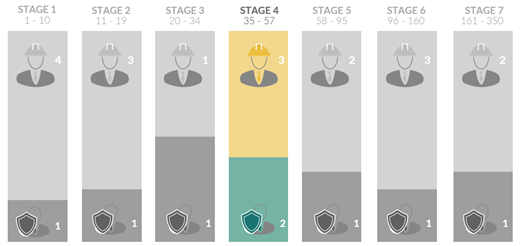Builder-Protector Ratio in a Stage 4 Company
In Stage 4, the ideal Builder-Protector Ratio is 3:2, which means confidence is slightly higher than caution. The 3:2 ratio in Stage 4 reflects an organization that is once again ready to embrace change (after intentionally slowing down in Stage 3), but at a slower pace than in Stages 1 and 2.
This graphic shows that in Stage 4 the bar for Protectors has decreased from its highest point in Stage 3. The Builder bar is now larger than the Protector bar, which means that the organization is exhibiting a higher degree of confidence than caution. The foot is back on the gas pedal to ensure the company has the momentum to grow.
This change is not a dramatic shift, however, from the balanced Builder-Protector Ratio of Stage 3. The organization’s confidence is still not as high as in Stages 1 and 2. A more moderate level of confidence is required to support the measured level of change the organization will need during Stage 4 as the management team is more formally developed and scalable systems and procedures are installed.
The organization requires additional structure to ensure that the influx of new employees doesn’t create too much caution. The leader can encourage confidence throughout the organization by establishing clear roles and responsibilities, a professional management team, and scalable processes and systems.
With an increase in confidence from Stage 3, the organization with a 3:2 Builder-Protector Ratio is once again confident and ready to intentionally set in place the human, procedural, and systems infrastructure needed to scale the business through Stage 4 and beyond.
One common misalignment in Stage 4 is an organization that never took its foot off the gas pedal in Stage 3. In this situation, the organization has continued to embrace constant change. When such an organization reaches Stage 4, it is often battered and worn out from the exhausting pace of change; that’s why it’s critical to focus on the infrastructure that will be needed to support its future growth, limiting change to only what is absolutely necessary.
A second situation that causes misalignment in Stage 4 comes from organizations that failed to make the transition from owner-centric to enterprise-centric, which ideally should have occurred in Stage 3. This organization is commonly lacking a strong management team to which the leader can delegate responsibilities. The result is leader burnout and stalled growth, which commonly shows up in a Builder-Protector Ratio that is too heavily weighted towards caution.
Finally, organizations that remain overly cautious in Stage 4 can be a result of adding a large number of new employees. If this increase in complexity is not met with clear structures, processes, and systems, the new hires can result in an increasingly protector-dominated mentality. If the organization is unable to increase the confidence of new and existing staff, the company can stall or retreat to Stage 3.
The key to building confidence in Stage 4 is the infusion of proper infrastructure into the organization, which provides structure, clarity, and focus. This proves to a growing team that the future for the organization is bright, and that leadership is successfully navigating the changing rules that come with growth.
Builder-Protector Ratio Misalignment
The CEO of a non-profit community pantry has slowly built up the organization to almost 50 workers, including volunteers. Located in a central part of the city, the pantry partners with churches and other local businesses to get regular donations and has expanded to include a soup kitchen that provides hot meals once a day. The CEO is passionate about her work and stays long hours at the facility to ensure that everything runs smoothly.
In order to manage the increasingly higher volume of work, she has promoted people within the organization to management roles. They are dedicated employees whom she trusts, but she doesn’t have confidence that they can fully maintain operations without her oversight. Opening the soup kitchen felt like a risk, but things have stabilized recently as everyone has grown to be more comfortable with the systems and procedures. However, when she is approached about adding another pantry location, she can’t bring herself to do it. As much as she wants to service another segment of the community, she is stretched too thin as it is, and knows she wouldn’t be able to keep up with three separate locations.
This CEO is still trying to run an owner-centric organization. The only way for it to continue to grow and expand is if she is willing to take at least some level of risk. With an ideal Builder-Protector ratio of 3:2, she needs to be willing to train and trust her managers to take on the day-to-day operations of the business. While there may be some short-term bumps along the way, the payoff over the long run will be a larger, more resilient organization that can serve more people across the city.
The concepts from this article were taken from The Professional Stage: Organizational ReWilding Rules for Business Growth. Available through The ReWild Group and Amazon, the book explores this and other concepts in-depth while providing illustrations to help business leaders incorporate the ideas into their organizations. Get your copy today to learn the rules for growth for companies with 35-57 employees.

